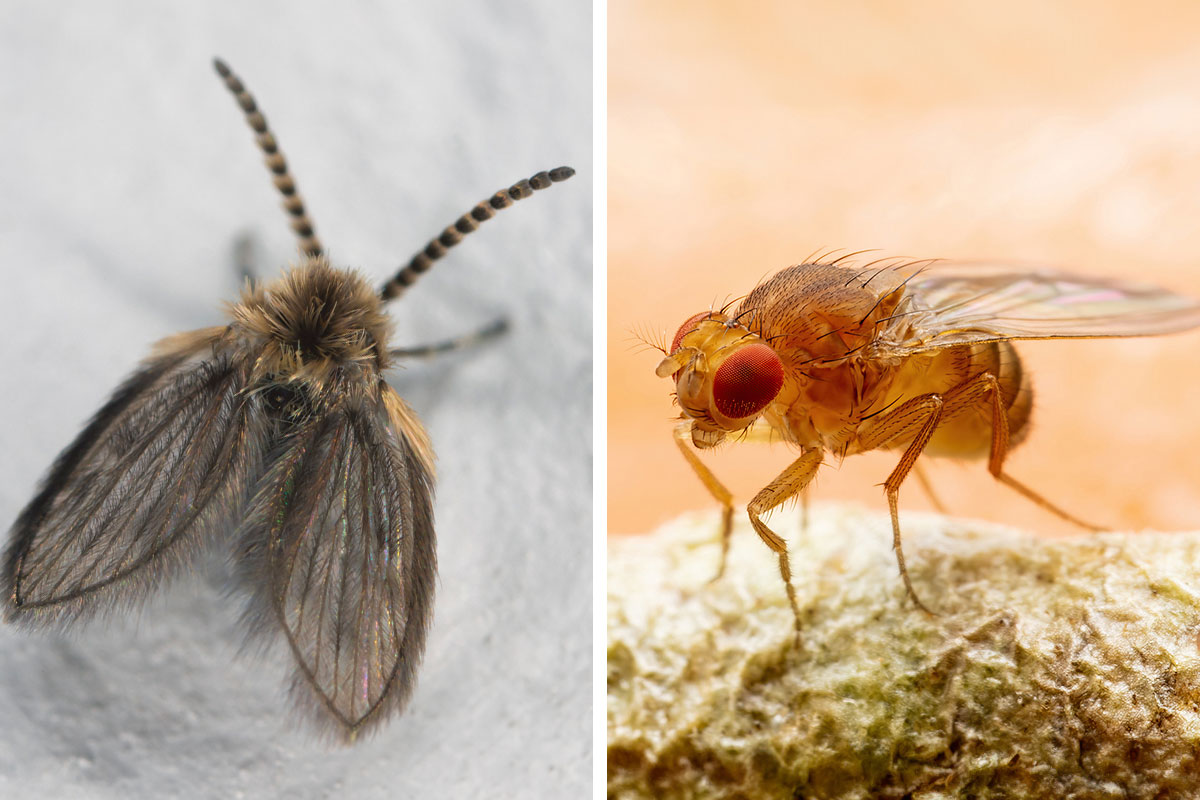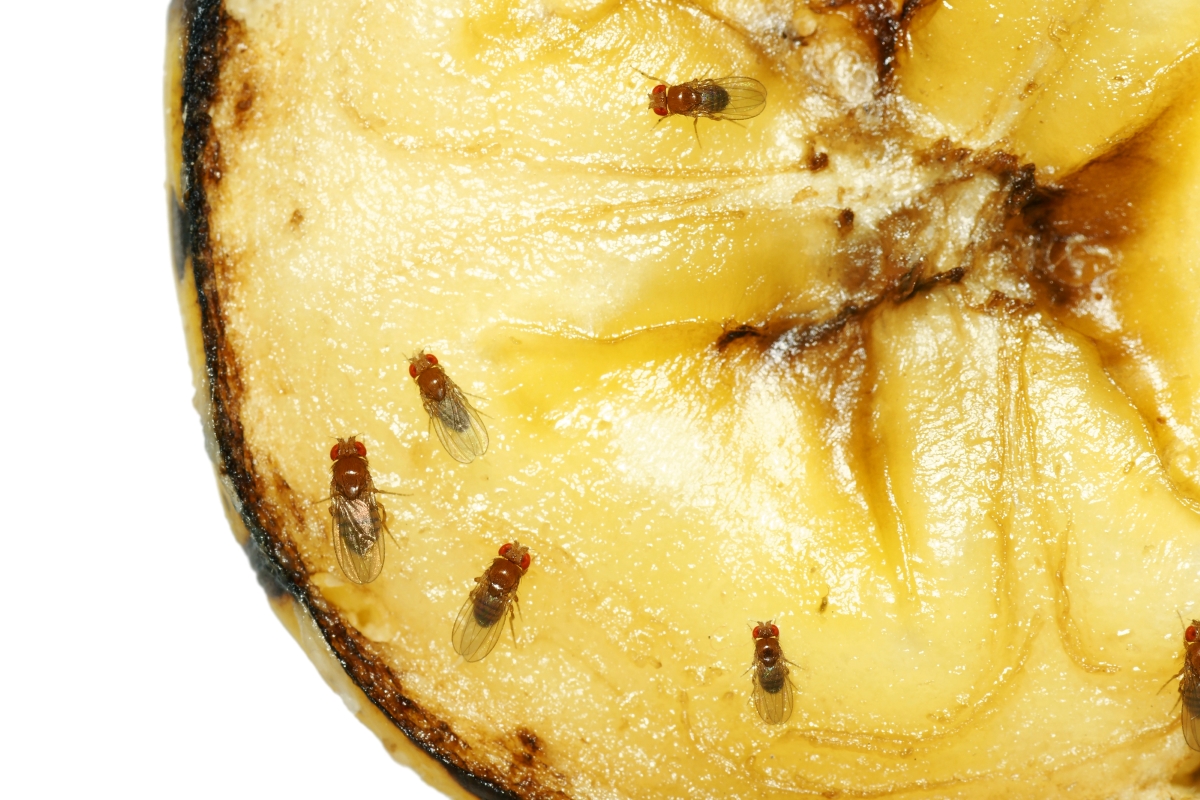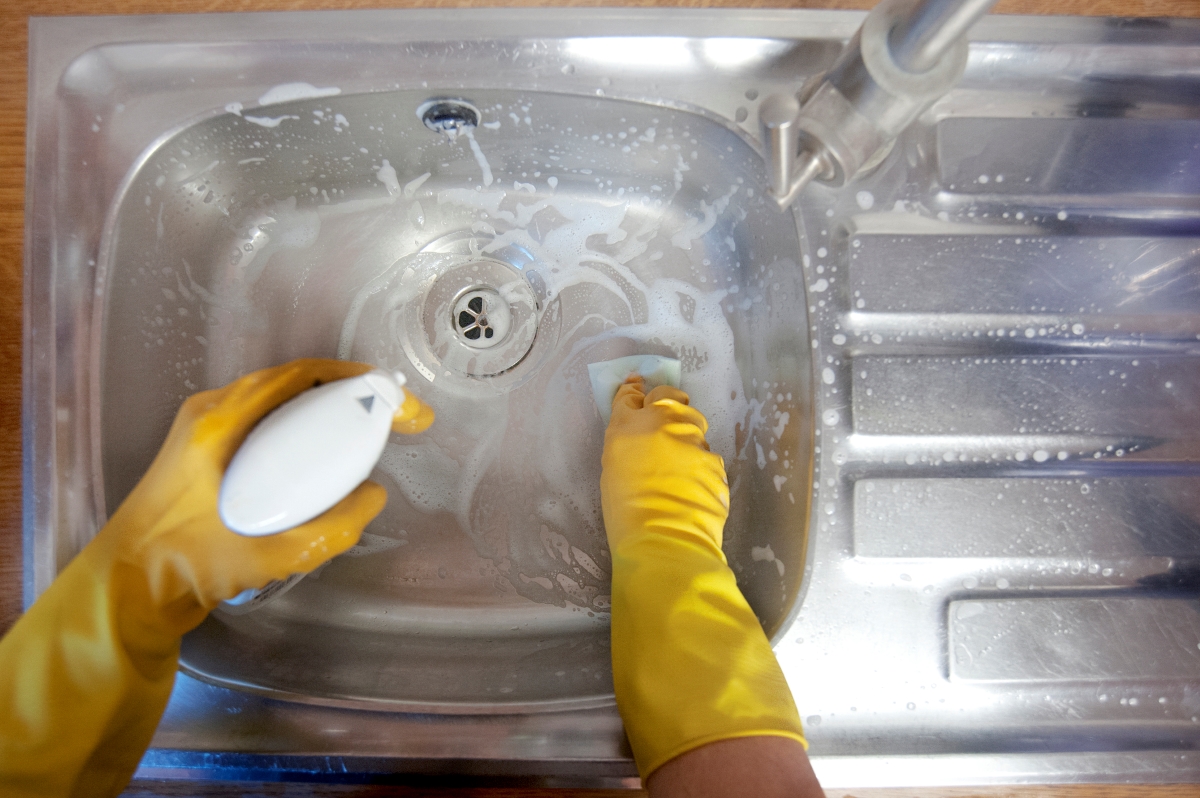

We may earn revenue from the products available on this page and participate in affiliate programs. Learn More ›
If tiny winged bugs have you constantly reaching for the flyswatter, you may be dealing with a bothersome fly infestation in your home. The question is, what kind of flies are they? Drain flies (also known as moth, filter, or sewage flies) and fruit flies (also called pomace or vinegar flies) are some of the most common culprits. Knowing how to tell the difference between drain flies and fruit flies will help you figure out the best solution for getting rid of them.
Although these tiny flying pests are often mistaken for each other, they have a few distinct characteristics that help to tell them apart. By learning about their appearance, behavior, feeding and breeding grounds, and the time of day they are most likely to appear, you will be able to tell which type of fly is causing havoc inside your home. Knowing which fly you’re dealing with should make it easier to eliminate the pests and prevent a drain fly or fruit fly infestation from happening again in the future.
What are drain flies?
Drain flies are small black flying bugs that are commonly found in bathrooms and kitchens. These pests often lay eggs in clogged sink and floor drains, which is how they earned their common name. While drain fly larvae may not be visible inside the drain, adult drain flies may be seen congregating on the surrounding sink or walls. To get rid of drain flies for good, it’s often necessary to thoroughly clean any affected drains.
- Scientific name: Psychodidae
- Body: Drain flies’ bodies are fuzzy and covered by wings. They also have long antennae.
- Color: Drain flies may be tan, gray, or black.
- Size: Most drain flies are very small, about 1.5 mm to 5 mm long.
- Location: Drain flies are drawn to organic material and standing water, so they’re usually found around leaky pipes, toilets, slow shower drains, or clogged sinks.
What are fruit flies?
Fruit flies are small flying pests that are drawn to sugary foods and fruits. These insects reproduce at a rapid rate, meaning a few fruit flies can quickly turn into a major infestation.
Although they do not pose a significant health risk, it’s a good idea to start getting rid of fruit flies as soon as possible to prevent this minor irritation from becoming an ongoing problem
- Scientific name: Drosophila melanogaster
- Body: Fruit flies have round heads and oval-shaped bodies covered by transparent wings.
- Color: Fruit flies are often dark colored but may also be tan or amber.
- Size: The average size of a fruit fly is 3 mm to 4 mm (length).
- Location: Fruit flies love food scraps and can be found around trash cans, fruit bowls, dirty dishes, and pet food dishes.
Differences Between Drain Flies and Fruit Flies

Are drain flies and fruit flies the same? No, these are actually two distinct pests. To get rid of bugs in the house, it’s essential to know what kind of pest you are dealing with. Fortunately, there are a few simple ways to distinguish these flies from each other.
Drain flies are darker and furrier than fruit flies.
A key difference between fruit flies and drain flies is their appearance. While both types of flies have small bodies, “drain flies…have a more moth-like, fuzzy appearance due to their hairy bodies and wings,” says Lorne Hanewich of Clark’s Termite & Pest Control, a service with several offices in central South Carolina. Fruit flies, in comparison, have a rounder, more slender silhouette and clear wings.
These flies also differ in color. Drain flies have a brown, black, tan, or gray exoskeleton. “The dark coloration of drain flies helps them blend into the organic matter (the ‘guck’) found in drains and sewage systems,” he adds. In contrast, fruit flies have brownish-yellow stripes or spots, often appearing brown or tan in color. Fruit flies also have large red or dark eyes; dark-eyed fruit flies tend to be slightly larger.
Fruit flies and drain flies prefer different feeding and breeding grounds inside a home.
Another way to figure out whether you’re dealing with fruit flies or drain flies is to note where they lay their eggs and what they eat. “Fruit flies are attracted to overripe fruits, vegetables, and fermenting liquids, making kitchens and garbage disposal areas common infestation spots,” says Hanewich. These pests can often be found in or around fruit bowls, sink drains, empty bottles, garbage bags, mops, and cleaning rags. They are particularly drawn to the sugar in fruits and vegetables, especially as yeast and mold start to break them down as they decay. Fruit flies are also attracted to meat, dairy, grains, garbage, and other items that provide a food source in dark, damp spots like sewer and water lines.
You may be wondering what causes drain flies to hang out in your house. Drain flies are attracted to decomposing material inside drains, and that’s where they feed and breed. “Drain flies…lay their eggs in the organic matter lining the walls of drains, sewage pipes, and septic tanks,” notes Hanewich. They can often be spotted flying out of an otherwise clean sink, which can be alarming.
Drain flies are nocturnal, while fruit flies tend to be more active during the daytime.
To help determine if you have drain flies or fruit flies, pay attention to the time of day they’re most active. Hanewich explains: “Drain flies are most active during the evening and night, making them more likely to be noticed when lights are dimmed. Fruit flies are diurnal, are attracted to light, and are commonly seen flying around kitchens and fruit bowls during daylight hours.”
The way each type of fly enters the home is also illuminating. Fruit flies usually get into the house as eggs on the surface of organic matter like fruits and vegetables. Drain flies sneak in through drains, windows, and the basement. They are often found resting on the walls or near breeding materials. If you’re seeing tiny black bugs in the bathroom as well as the kitchen, these are more likely to be drain flies.
DIY traps can help you catch and identify which flying pest you’re dealing with.

Sometimes the only way to figure out the type of fly invading a home is to catch a few and examine them closely. It’s fairly easy to construct a DIY trap that will kill the bugs and help you make an ID.
A common DIY trap for fruit flies involves using apple cider vinegar as bait in a container covered with plastic wrap and punctured with small holes. Other fruit fly traps lure the insects with liquid bait or light. They are then killed using electric shocks, adhesive pads, or some sort of physical barrier they can’t escape. Plug-in fly traps employ a combination of light and sticky cards to attract and trap flies.
To catch and kill drain flies, Hanewich advises creating a DIY trap that uses “a mixture of sugar, water, and dish soap in a container, placed near affected drains.”
How to Prevent Drain and Fruit Flies

The University of Maine Cooperative Extension recommends addressing fly infestations by regularly cleaning drains or other places where fermenting materials can accumulate. However, some other sensible cleaning practices can also aid in getting rid of the annoying pests.
According to Jerry Wang, owner of DIY Pest Warehouse, “Fruit flies will lay eggs around decaying fruits and vegetables. When disposing of fruits and vegetables, the trash bags must be sealed so that air doesn’t come in and out.” Sealing the bags prevents fruit flies from escaping, he adds, “and when the eggs hatch, they will be stuck inside the trash bag.”
When dealing with drain flies, Wang highlights the importance of properly cleaning kitchen sink pipes. “There is a U-shape part of the sink pipe. Sometimes there may be food sediments that build up on the bottom part of the pipe,” he says. “That’s where the drain flies will lay eggs. Flush out the pipe with strong water pressure, and make sure it’s 100 percent clear.”
Follow these additional cleaning tips to prevent fruit flies and drain flies from becoming a problem:
- Empty and clean garbage cans and compost bins frequently.
- Dispose of overripe fruit.
- Clean and tighten food container lids.
- Wipe down counters and tables promptly after mealtimes.
- Clean sink drains with a bottle brush and a grease-cutting cleanser followed by a hot water rinse.
- Launder dish towels and hand towels regularly.
- Dry mops thoroughly since they are a common breeding ground for fly eggs and larvae.
FAQs
Gnats, drain flies, and fruit flies have distinct appearances and behaviors. Drain flies congregate around standing water or drains and have a moth-like, fuzzy appearance. Fruit flies resemble tiny house flies and are attracted to rotting food. It can be especially difficult to differentiate fungus gnats vs. fruit flies, but gnats have longer legs, like mosquitoes.
The presence of drain flies does not necessarily mean that you have mold in the home. However, drain flies are attracted to moisture and standing water, and these conditions have the potential to lead to mold growth. It’s always wise to find and eliminate any moisture sources that attract drain flies.
If fruit flies are suddenly appearing it means they have found a source of food in your home. Some common culprits include overripe or rotting fruit, dirty dishes, or overflowing trash bins.
Drano can be effective in getting rid of fruit flies and drain flies. However, the harsh chemicals in Drano may be harmful to the environment and hard on your plumbing. A natural drain cleaner, such as a baking soda and vinegar solution, may be a safer alternative.
The sudden appearance of drain flies can be a sign of a broken or clogged pipe. If you have a persistent drain fly issue that doesn’t go away with drain cleaning, it may be a good idea to call in a plumber.
